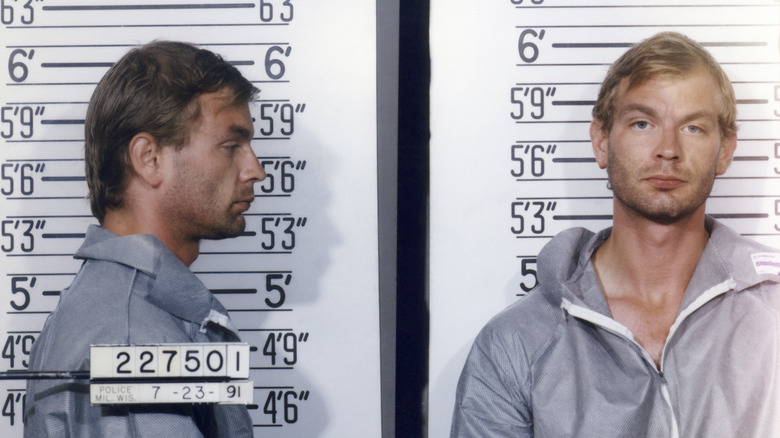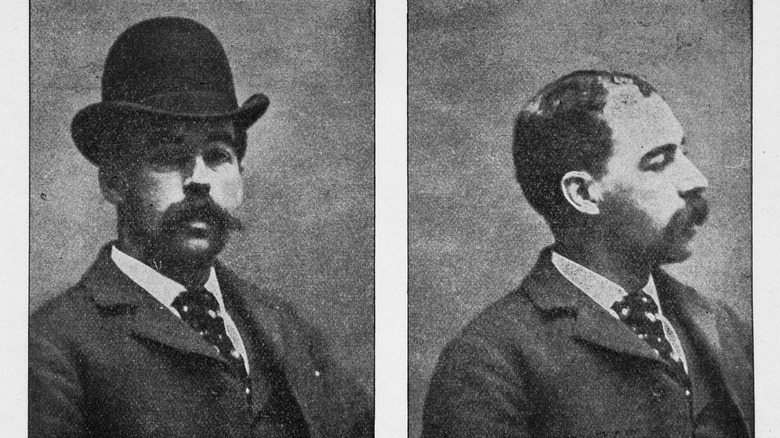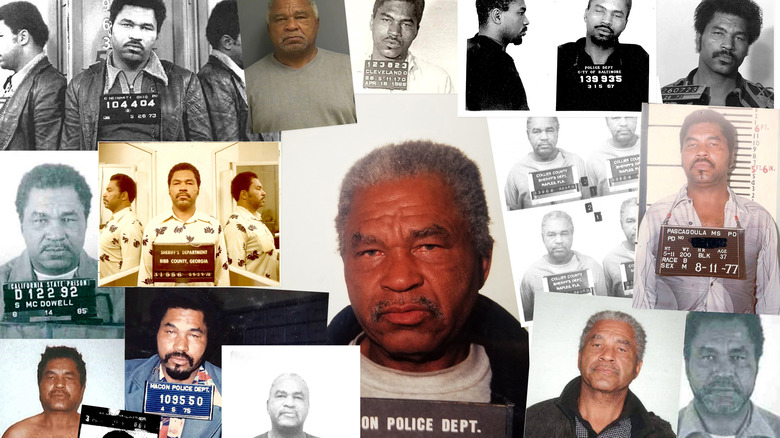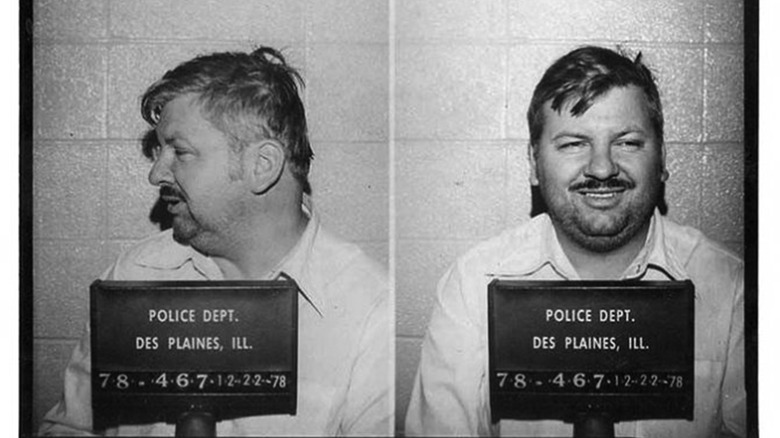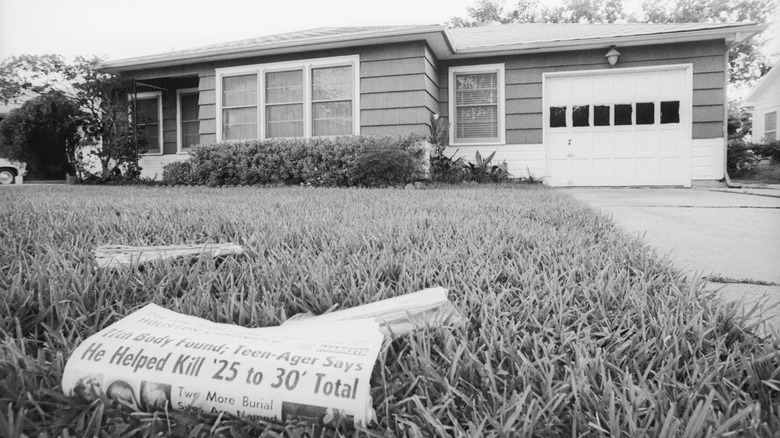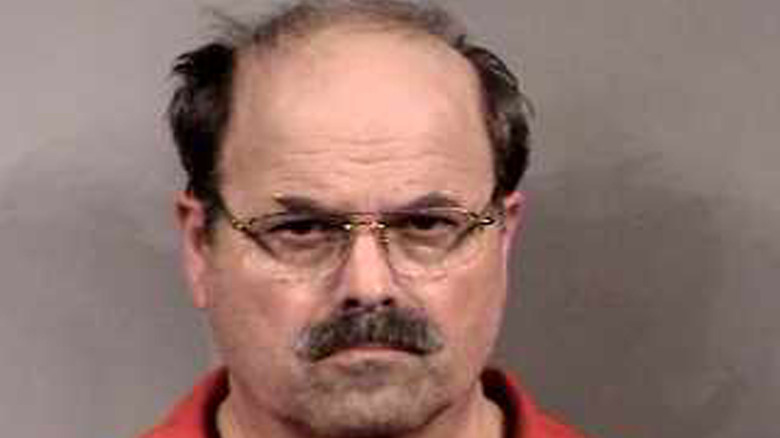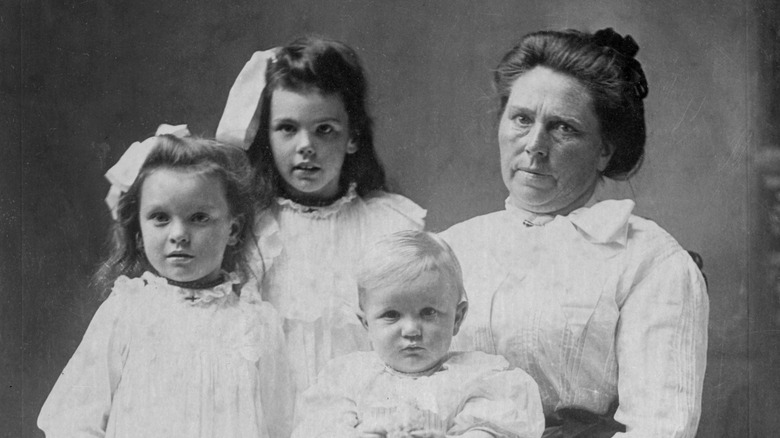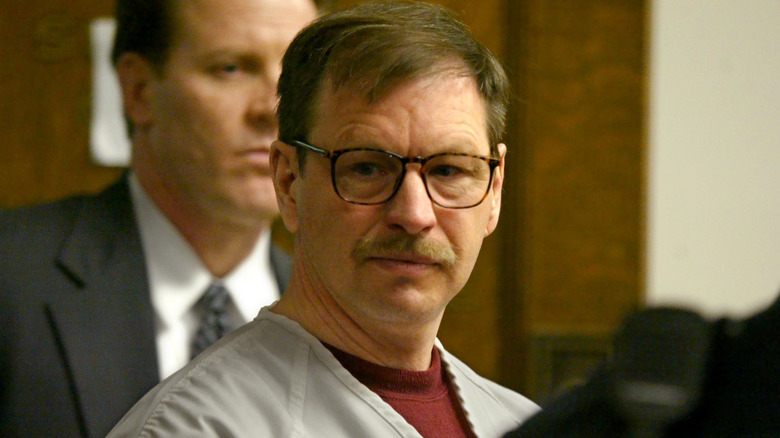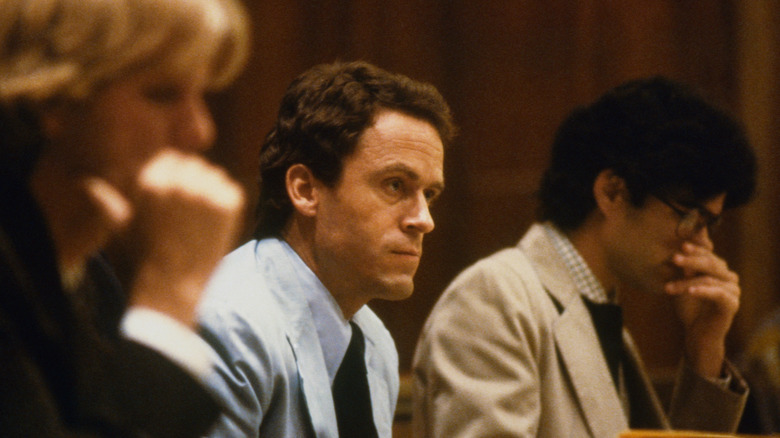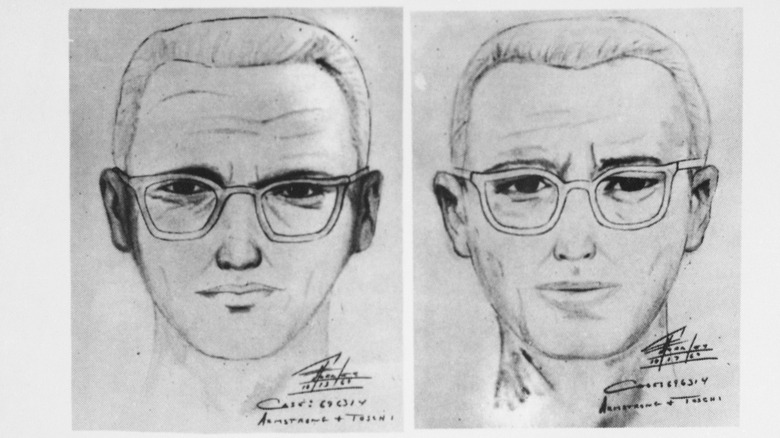The Worst Serial Killers In American History
Serial killers have a strong — if seemingly odd — hold on the human imagination. Many people today find themselves grimly fascinated by the exploits of killers, to the point where experts in social sciences, mental health, communications, and other fields have made it a point of research interest to understand why so many of us find serial killers to be so engrossing. Of course, this is not a new fascination, as cases like that of the 16th-century accused werewolf Peter Stubbe (and the breathless pamphlet accounts of his crimes that followed Stubbe's trial and execution) demonstrate. That's clearly continued into the modern day, with a significant media industry that's focused on true crime and the chilling exploits of some of the worst serial killers in American history.
What makes a serial killer the worst? It could be the sheer number of victims they targeted, of course. Other killers have terrorized a region for years, consistently evading capture or, in very few cases, never being captured at all. Some have also gained notoriety for the gruesomeness or cruelty of their crimes.
Amongst all the lurid details, however, it's too easy to forget that these killers took real lives — those of people who were mourned by friends and family, and whose survivors have had to navigate the trauma of losing a loved one in such a shocking and often abrupt manner. Perhaps it's more for their sake that we remember the crimes of some of America's worst serial killers.
H.H. Holmes
Today, the story of H.H. Holmes seems difficult to believe. After being filtered through whispers, rumors, and poorly researched blogs, the idea of a sprawling murder castle built by a bloodthirsty conman can seem fantastical. But, a look at the untold truth of one of America's first serial killers indicates that at least part of the legend was real.
Born Herman Mudget in the mid-19th century, young H.H. Holmes was reportedly very intelligent, yet also nearly dropped out of medical school before making his way to Chicago. There, he worked as a pharmacist and hotel proprietor — the last was especially profitable when the World's Columbian Exposition came to town in 1893. Some of those who went to the big city to see the fair also became victims of Holmes, who was said to have installed an elaborate network of hidden passageways, secret rooms, and killing devices in his hotel. The reality is that much of the 200 victim count attributed to him is legend, drummed up by unscrupulous journalists and Holmes' self-aggrandizing memoir (in which he admitted to murdering 22 victims). It's more likely that he killed around nine people, but those murders were nonetheless awful and included at least four children.
Holmes wasn't taken down by the supposedly Poe-like horrors of his murder complex. Instead, it was insurance fraud. When he was arrested, evidence indicated that he had killed a business associate, Benjamin Pitezel, and Pitezel's three children. He was executed for Pitezel's murder in May 1896.
Herb Baumeister
The name Herb Baumeister may not catch the attention of many, but though he had a normal existence on the surface — complete with a wife, three children, and a sprawling estate near Indianapolis known as Fox Hollow Farm — part of the truth about Baumeister is that he led a secret second life.
When his family was out of town, Baumeister is believed to have gone to Indianapolis gay bars, where he picked up single men, returned to his home, killed them, and disposed of their remains nearby. His wife, Julie, eventually admitted that her son found a human skull on the Baumeister property in December 1994. Yet, when she questioned Herb, he brushed it off as an old anatomy specimen he'd discarded in the woods. Julie didn't immediately report the gruesome find to the police, but investigators continued looking into the growing numbers of missing men in the area, eventually focusing on Baumeister. He fled the area and died by suicide in a Canadian park in July 1996.
Investigators found a shocking number of bones scattered throughout the woods behind the Baumeister home. Just nine victims have been identified, but it's believed Baumeister killed at least 25 and perhaps more. Remains were being found at Fox Hollow Farm and identified as recently as 2023. Baumeister may have also been the I-70 strangler, who killed an estimated 11 victims in the 1980s and '90s. Those killings seemingly stopped around the time Baumeister moved into Fox Hollow Farm.
Samuel Little
The very dubious title of most prolific American serial killer likely belongs to Samuel Little. That's not just an exaggeration, either, as no less than the FBI has determined that Little likely told the truth when he confessed to killing 93 people from 1970 until 2005.
The truth about Samuel Little includes the fact that he was frequently apprehended during that period — typically for changes like assault and theft — but was often released. After DNA evidence connected him to the deaths of Carol Ilene Elford, Guadalupe Duarte Apodaca, and Audrey Nelson Everett, Little was found guilty of their murders in 2014. He began serving a life sentence that year and died in prison at age 80 in 2020.
But how was Little able to take so many lives over such a long period, especially when he was known to authorities? That's largely because his victims were often low-income, Black, sex workers, and drug users, who were frequently written off as unreliable witnesses or whose deaths were deemed unworthy of investigation. Some of Little's victims were never found or even named, though he confessed to their killings towards the end of his life and drew portraits of some of them from his prison cell. Other victims had been found years earlier, but their deaths had been dismissed as overdoses or accidents and were noted without further investigation ... at least, until Little began to speak.
John Wayne Gacy
John Wayne Gacy has become a strange figure in American culture, with his violent string of murders contrasting with a seemingly normal facade — so normal, in fact, that he performed as a clown for fundraisers and parties, was a socially active community member, and was even a local politician. He also had an exceedingly dark past that included childhood sexual assault, poor health, and discrimination based on sexuality.
While others have endured similar challenges and managed to avoid becoming serial killers, Gacy did not. In 1968, he was accused of sexually assaulting an underage boy, which led to a 10-year prison sentence and a divorce from his wife. He was paroled after only 18 months, faced further charges, escaped conviction, and then started a second life as a contractor. Though he remarried and had a successful business, Gacy reportedly still assaulted young men and began his killings in January 1972, when he stabbed teen Timothy McCoy after a sexual encounter in Gacy's home.
By 1978, Gacy was finally connected to a victim, and police began to focus an investigation on him. A search of his Norwood Park, Illinois, home uncovered victims' belongings, syringes, and weapons. There was also the small matter of the 29 bodies on his property, including some that were buried in the crawlspace directly beneath the home. Four more sets of remains found nearby were also attributed to Gacy. After his arrest in December 1978, Gacy admitted to an estimated 30 of those deaths and was executed by lethal injection in 1994.
Dean Corll
Between 1970 and 1973, young men and boys in the Houston area went missing with little or no explanation, leaving families bereft and with precious few answers regarding what happened to their loved ones. Then, in August 1973, the terrible truth came out: a monster had been amongst them. That was Dean Corll, who helped manage his family's candy factory and lived a seemingly unremarkable life. But the reality was that Corll was a vicious serial killer, whose crimes were finally uncovered after he was shot dead in a suburb of Houston.
Corll's killer was Wayne Henley, a teenage boy who was one half of the duo who assisted Corll in finding victims. The other was another teen, David Brooks. Perhaps boosted by bribes Corll offered to Henley and Brooks, the trio scouted boys as young as 13, urging them to enter Corll's vehicle with offers of a ride or a party invitation. Once at another location, Corll would restrain, brutally assault, and kill the victim. Sometimes, he also forced the victim to write to or call their parents, falsely claiming to be safe.
Brooks and Henley later confessed that they helped Corll move and bury victims' bodies — some of which belonged to their friends. At the time, 27 remains were linked to Corll, but later DNA testing found another, bringing his total number of known murders to a chilling 28. Henley and Brooks both received life sentences for their part in the killings.
Dennis Rader
From 1974 to 1991, the BTK killer brought terror to Wichita, Kansas, by killing an estimated 10 people. It all began with the murders of the Otero family, including parents Julie and Joseph and two of their children, 11-year-old Josie and 9-year-old Joey. They were found by the surviving Otero children. Later that year, BTK placed an unsigned confession in a library book, referencing his preferred method to "bind them, torture them, kill them" and giving rise to the BTK moniker.
Once news media took the story on, the killer engaged in an occasional back and forth with reporters, sending a poem to one outlet and even telephoning police to report one 1977 killing. He sometimes seemed eager for the attention, whining to one TV station in 1977, "How many people do I have to kill before I get a name in the paper or some national attention?" (via Britannica).
BTK last killed in 1991, leaving the case to seemingly turn cold. But 2004 news reports on the anniversary of the Otero family murders pushed him to begin contacting the media and police again. One package sent by the killer included a disk that authorities traced back to Dennis Rader, a control-focused family man, active church member, and Boy Scout troop leader. Further investigation and DNA testing — using a sample provided by Rader's daughter — led to Rader's February 25, 2005 arrest. He pled guilty and was sentenced to 10 consecutive life terms.
Belle Gunness
It's notoriously difficult to determine just how many people met their ends at the hands of Belle Gunness. However, evidence suggests that her victims were many.
Gunness, born Brynhild Streseth in 1859 in Norway, immigrated to the U.S. in 1881. Just a few years later, she married Mads Albert Sorenson. Not long after that, the family's home and store burned down, producing a nice little insurance payout. Then, Mads died suddenly — conveniently enough, on the single day that two life insurance policies covering him were both in effect. She then married Peter Gunness and had a daughter with him. Both died in short order. Now a two-time widow, Gunness set about finding a new partner through newspaper ads. Each respondent was asked to travel to her Wisconsin farm with cash in hand. Each then proceeded to mysteriously disappear.
By 1908, however, family members of the missing men were growing suspicious. Just when the net seemed to be closing around Gunness, however, another fire hit her home. Locals who responded found four remains in the smoldering ruins, attributing three to her children; yet the fourth, which was missing key elements like its skull, didn't obviously belong to Gunness. Further investigation found more than 12 graves scattered throughout the property, contributing to an estimated victim count of 40 individuals. Gunness, who was rumored to have escaped, was never found alive or definitively identified as one of the dead.
Gary Ridgway
Like other serial killers, Gary Ridgway preyed on some of the most vulnerable people in society, targeting those whose transient lives and ostracization would make their disappearances all the less likely to gain attention. For Ridgway, those victims were typically young women running away from home or working as sex workers in and around King County, Washington. Starting in 1982, Ridgway began picking up these girls and women and killing them, depositing their remains near the Green River and earning the moniker of the Green River Killer. In 2003, he would finally be charged with the murder of that first known victim, Wendy Lee Coffield, along with many other women. His youngest victim, runaway Wendy Stephens, was only 14 and only identified in 2020. As of 2024, investigators are still working to identify individuals whose remains are connected to the case; in December 2023, DNA testing identified yet another girl, 15-year-old Lori Anne Razpotnik, whose remains had been sitting unidentified since 1985.
But for nearly 20 years, he evaded capture and killed at least 49 people. Ridgway later stated that he may have killed as many as 80, but it's unclear if he was genuinely confessing or simply out to get more attention from investigators and the press.
Ridgway was caught in 2001, after DNA testing conclusively linked him to genetic material recovered from some of the women's remains. To avoid execution, he agreed to lead investigators to more remains. Ridgway was sentenced to life in prison in 2003
Jeffrey Dahmer
The sheer brutality of Jeffrey Dahmer's crimes is so shocking that he's remained a ghoulish figure in American culture decades after his 1994 death.
Beginning in 1978, and continuing until he was finally apprehended in 1991, Jeffrey Dahmer largely targeted the gay community in and around Milwaukee, Wisconsin. His first victim, a teenage hitchhiker named Steven Hicks, established a common pattern for Dahmer, who incapacitated Hicks with alcohol and a blow to the head, followed by strangulation. By his third victim in early 1989 — Anthony Sears — Dahmer began retaining human remains. He also became increasingly ritualistic and attempted to lobotomize victims. In May 1991, he was nearly caught when 14-year-old Konerak Sinthasomphone escaped Dahmer's apartment. Police intercepted Sinthasomphone, who was nude and disoriented, then handed him back to Dahmer when the killer maintained that Sinthasomphone was his drunk boyfriend. Dahmer had previously been convicted in 1988 of sexually assaulting Sinthasomphone's brother.
Police looked around Dahmer's apartment, but their investigation was exceedingly poor; they missed the remains of Tony Hughes, which were clearly visible in one room. After the police left, Dahmer proceeded to kill Sinthasomphone as well. Four more men would die before police finally arrested Dahmer on July 22, 1991, after Tracy Edwards told police that Dahmer had drugged him. When police actually investigated Dahmer's apartment, they found a ghoulish array of human remains. Dahmer was arrested and ultimately confessed to killing 17 people. He was killed in prison by a fellow inmate in 1994.
Ted Bundy
Ted Bundy had a weird hold over people — some people, anyway. Though he was convicted of three murders, confessed to 28, and was executed in Florida in 1989, some maintained that he was compellingly intelligent and charismatic. But, no matter how much some may have found themselves fascinated by Bundy, the chilling reality of his crimes handily labels him as one of America's worst serial killers.
Bundy's killings began in February 1974, when he murdered 21-year-old Lynda Ann Healy of Seattle. He killed 11 more women in 1974 alone, at least according to Bundy's confession. In August 1975, he was arrested in Utah, but even though officers found objects like gloves, masks, rope, and handcuffs in his car, Bundy was released on bail in short order. He was arrested again in October 1975, after Carol DaRonch identified him as her failed abductor in a 1974 incident. He was eventually also charged with the murder of Caryn Campbell, but, while on trial in 1977 in Colorado, he escaped twice and eventually found himself on the run.
By January 1978, Bundy was in Tallahassee, Florida, where he targeted the Chi Omega sorority in a brutal attack that killed Margaret Bowman and Lisa Levy, while seriously injuring two other women. He left the sorority, attacked another woman in her apartment, then escaped. Less than a month later, he killed 12-year-old Kimberly Leach, who was to be his last victim before his arrest on February 15, 1978.
The Zodiac killer
What if a serial killer is never caught? What if they continued — or even continue — to walk undetected amongst us, but with murder still on their minds? That horror is undeniably part of the story of the "Zodiac Killer," whose 1968-1969 murders of at least five people in California spawned wild media speculation and widespread fear.
Some suggest that the 1963 shooting deaths of Robert Domingos and Linda Edwards in Santa Barbara County were done at the hands of the killer. Some also believe that he's responsible for the 1966 death of Riverside City College student Cheri Jo Bates. Others maintain that the killings began in 1968, when a young couple — Betty Lou Jensen and David Faraday — was killed in a car at a remote spot in Benicia, California. Another couple — Darlene Ferrin and her friend Michael Mageau — were targeted near Vallejo. Ferrin died, while Mageau survived, yet was unable to provide a useful description.
Soon after, a person claiming to be the killer began sending taunting letters to local newspapers. Another couple in a car was stabbed in September 1969; Cecelia Shepherd died, but Bryan Hartnell survived and provided a chilling description of a man in a black hood with a circle and cross emblem. Many more letters, some containing mysterious ciphers, a possible police encounter with the killer, and more attacks followed, but no one was apprehended. Though the cipher was solved in 2022, it didn't point to a clear suspect. The case remains unsolved.
If you or anyone you know may be the victim of child abuse, sexual assault, is struggling or in a crisis, contact the relevant resources below:
-
The Childhelp National Child Abuse Hotline at 1-800-4-A-Child (1-800-422-4453) or contact their live chat services.
-
The Rape, Abuse & Incest National Network website or contact RAINN's National Helpline at 1-800-656-HOPE (4673).
-
Call or text 988 or chat 988lifeline.org
